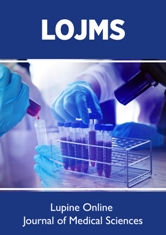
Lupine Publishers Group
Lupine Publishers
Menu
ISSN: 2641-1725
Research Article(ISSN: 2641-1725) 
Prognostic Role of Invasion and Proliferation Markers in Patients with Macro and Giant Non-Functional Pituitary Adenomas Volume 6 - Issue 5
Urmanova Yu M1*, Mirtukhtaeva MB2, Khudaybergenov Sh A3, Khaydarova RT4, Alieva DA5 and Yunusova Kh R6
- 1Doctor of Medical Sciences, Professor of the Department of Endocrinology, Paediatric Endocrinology, TashPMI, Service address: Tashkent, 100125, st. Mirzo Ulugbek, 56
- 2Endocrinologist of the Department of Neuroendocrinology with Pituitary Surgery RSNPMCE Ministry of Health of the Republic of Uzbekistan named after academician Y.H. Turakulova, employment contract, Service address: Tashkent, 100125, st. Mirzo Ulugbek, 56
- 3Tashkent Paediatric Medical Institute, Department of Surgical Diseases, assistant professor, Service address: Tashkent, 100140, st. Bogishamol, 223
- 4Assistant professor at the Center for Advanced Training of Medical Personnel, Department of Endocrinology, Service address: Tashkent, 100125, st. Mirzo Ulugbek, 56
- 5RSNPMCE Ministry of Health of the Republic of Uzbekistan named after academician Y.H. Turakulova, employment contract, Service address: Tashkent, 100125, st. Mirzo Ulugbek, 56
- 6Tashkent Paediatric Medical Institute, student of 4 course Service address: Tashkent, 100140, st. Bogishamol, 223
Received: March 26, 2024; Published: April 03, 2024
*Corresponding author:Urmanova Yu M, Doctor of Medical Sciences, Professor of the Department of Endocrinology, Paediatric Endocrinology, TashPMI, Service address: Tashkent, 100125, st. Mirzo Ulugbek, 56.
DOI: 10.32474/LOJMS.2024.06.000246
Abstract
Relevance: The assessment of the KI-67 and P53 using immunohistochemistry, usually with monoclonal antibodies of MIB1, is mandatory for evaluating proliferation in patients subject to transnasal adenomectomy of the pituitary gland.
Goal: To study the prognostic significance of invasion and markers of proliferation in patients with macro and giant inactive pituitary tumors.
Materials and Methods: In total, 272 patients with macro and giant naga were examined. Of the 272 patients with the naga in the study, 151 patients (men and women) took part in the study) Research methods included: 1) general clinical (study of endocrine, neurological statuses), 2) instrumental (perimetry for all colors, eye bottom, visual acuity, 3) ECG, CT/MRI of the Turkish saddle and adrenal glands, 4) ultrasound of the internal and genitals, etc.), 5) hormonal blood tests (STG, IFR-1, LG, FSG, PRL, TSL, ACTH, prolactin, testosterone, estradiol, progesterone, cortisol and immunohymph hand-chemical studies.
Results: The observed frequency of immunoexpression of proliferation markers was 40%/50% for P53 (≥3+), 50%/60% for Ki-67 (≥2+). Tumors with immunoexpression of at least 2 markers with a high proliferation index were observed in 54% cohorts and regarded as proliferative adenomas.
Conclusion: Giant inactive pituitary adenomas of the pituitary gland are often accompanied by invasive growth in the surrounding anatomical structures (more than 80% of cases), which is the main factor that limits the radicality of surgical intervention and increases the number of relapses.
Keywords: NFP; Giant pituitary adenomas
Introduction
Pituitary adenomas are mostly benign, and their first symptoms are associated with hypersecretion of hormones or hypopituitarism, when normal pituitary tissue is compressed [1,2]. Some of these tumors may be associated with evidence of infiltration, destruction, and invasion of adjacent tissues during their development, known as invasive pituitary adenomas. This term was first proposed by Jefferson [3,4], who considered these adenomas to be local malignant tumors. However, there is still no clear definition of aggressiveness. Some authors suggest that they are often recurrent tumors that have a large volume, accelerated growth, invasion of adjacent structures and resistance to multimodal treatment. (surgical, radiation and pharmacological) treatment [5-8]. In 2004, the World Health Organization (WHO) classified pituitary adenomas into typical adenomas, atypical adenomas, or carcinomas [8]. Unfortunately, this classification process does not establish a reliable relationship with clinical behavior or risk of carcinogenesis. Some typical pituitary adenomas exhibit an aggressive phenotype, and some tumors considered atypical pituitary adenomas may not recur or may be resistant to pharmacological treatment. Even aggressive non-metastatic pituitary adenomas can have histopathological features similar to carcinomas [9]. These tumors should be diagnosed at an early stage, which requires careful clinical and radiological monitoring. In these cases, intensive treatment protocols should be considered.
Recently, Trouillas et al. [10] proposed a prognostic clinicopathological classification that takes into account both radiological and histological parameters and recommends the following classification system: 1A, non-invasive; 1B, non-invasive and proliferative; 2A, invasive and nonproliferative; 2B, invasive and proliferative; 3, metastatic. These authors [10] indicated the predictive prognostic value of the classification based on 8 years of follow-up. The role of clinical, radiological and immunostaining markers of tissue proliferation on clinical outcomes remains unclear, and the proposed tumor categories need to be confirmed in long-term studies of large series. Evaluation of Ki-67 by immunohistochemistry, usually with the monoclonal antibody MIB1, is mandatory to assess proliferation. There is an assumption that Ki-67 does not differ significantly between hormone-secreting and non-secreting pituitary tumors [11]. Methodological issues, difficulties of interpretation and the use of different cut-off values in different studies [12,13] may explain why the interpretation of Ki-67 has recently been reformulated, moving away from the 3% cut-off value in the previous WHO classification. pituitary tumors to estimate the percentage of Ki-67-positive nuclei without an exact cutoff in the 2017 WHO classification. NF-PitNET studies have shown that the Ki-67 proliferative index remains the second parameter in predicting relapse after invasion of surrounding structures [14]. Ki-67 proliferative index and mitotic activity should be carefully assessed in apoplectic PitNETs, since the proliferation of inflammatory cells and cells surrounding necrosis should not be interpreted as tumor cell proliferation. In this situation, proliferation in well-preserved areas of the tumor should, if possible, be assessed and the use of additional immunolabeling with a lymphocyte marker should be considered to assess the proportion of inflammatory cells among Ki-67-reactive cells. Although p53 mutation is very rarely detected in sporadic PitNETs, its nuclear accumulation detected by immunohistochemistry has suggested the potential aggressive behavior of pituitary tumors in previous studies, leading to the inclusion of p53 among the atypical adenoma classification criteria in the previous WHO classification. However, there is still no clear opinion on its interpretation for pituitary tumors, including non-functioning ones [15, 16].
According to Zakir JC, Casulari LA, Rosa JW [17] although some pituitary adenomas may have aggressive behavior, the vast majority are benign. There is still debate about predictive factors regarding the biological behavior of these specific tumors. The authors emphasized that parasellar invasion predominates as a strong predictor of tumor recurrence. Pronounced suprasellar growth should be considered as a parameter of invasion and could affect the prognosis. All of the above emphasizes the relevance of this area.
Target
Explore pRognostic significance of invasion and proliferation markers in patients with macro and giant non-functional pituitary adenomas.
Material and Methods
A total of 272 patients with macro and giant NFPA were examined. Of the 272 patients with NFPA, 151 patients (men and women) who received treatment in the neuroendocrinology department of the Republican Specialized Scientific and Practical Medical Center of Endocrinology and who applied to the outpatient clinic in the period 2020 - 2022 took part in the study prospectively. Of these, 85 (56.3%) were men, 66 (43.7%) were women, who were constantly monitored over time. Average age: men were 48.12 years, women - 46.15 years. The duration of the disease ranged from 2 months to 5 years. 20 healthy individuals of the corresponding gender and age formed the control group. Based on the size of pituitary adenomas, prospectively observed patients (151 patients) were divided into 2 groups: group 1 – patients with macro NFPA – 55 people, group 2 – patients with giant NFPA – 96 people. In table 1 The distribution of patients by gender and age is given (data from a prospective study).
Research methods included: 1) general clinical (study of endocrine, neurological status), 2) instrumental (perimetry for all colors, fundus, visual acuity, 3) ECG, CT/MRI of the sella turcica and adrenal glands, 4) ultrasound of the internal and genital organs, etc.), 5) hormonal blood tests (GH, IGF-1, LH, FSH, PRL, TSH, ACTH, prolactin, testosterone, estradiol, progesterone, cortisol (ICL method). In addition, postoperative material was subjected to histological diagnostics at the Republican Scientific Research and Medical Center of the Ministry of Health of the Republic of Uzbekistan named after Academician Y. Kh. Turakulov (histology office). Proliferation markers Ki-67 and p53 were obtained using a semi-quantitative method. Results were considered positive for cases where p53 ≥ 3+ (immunoexpression in 25 to 50% of cells), Ki-67 ≥ 2+ (immunoexpression in 10 to 25% of cells), and c-erbB2 ≥ 2+ (positivity in more than 10% of cells) via local protocols [11,12].
The obtained data were processed using Microsoft Excel and STATISTICA_6 computer programs. The arithmetic mean (M) was calculated, standard deviation of the arithmetic mean or error of the mean arithmetic of all n repetitions (m). The reliability of differences in levels between groups was assessed by the confidence interval and Student’s test (p). Differences were considered statistically significant at p<0.05.
Results of own research and their discussion. A total of 60 TAG (transnasal adenomectomy of the pituitary gland) were performed (candidate of medical sciences Akbutaev A.M., prof. Michael Powell from the UK). Repeated operations on the pituitary gland were performed in 5 patients (7.3%). 5 patients (7.4%) received radiation therapy and 1 received chemotherapy (1.5%). 20 immunohistochemical studies were analysed in 10 patients with macro NFPA and 10 patients with giant NAG in comparison with MRI data of the pituitary gland. All MRI image slices were reviewed. Cavernous sinus invasion was considered in cases where the tumor volume occupied more than 2/3 of the internal carotid artery [eleven] or grade 3 and 4 tumors according to Knosp et al. [18] and Edal et al. [19] classifications respectively. Invasion of the sphenoid sinus was considered in cases where MRI showed erosion of the floor of the sellar bone and/or tumor invasion of the sphenoid sinus (grades 1 and 2 according to Edal et al. [19]). Tumors with significant suprasellar extension (grade 4, Edal et al. [19]), causing obstructive hydrocephalus in close contact with the third ventricle and in close proximity to brain parenchymal tissue, were also considered invasive. Table 2 shows the distribution of patients according to the nature of the formation of the sellar region (Table 2).
Table 2: Distribution of patients according to the nature of growth of the formation of the sellar region.

As can be seen from Table 2, hemorrhage into the pituitary stroma occurred in 5 (9.09%)/12 (12.5%) cases, parasellar invasion - in 42 (76.4%)/78 (81.3%), suprasellar growth - in 34 (61.8%)/67 (69.8%), infrasellar expansion -44 (80%)/57 (59.4%), expansion of the third ventricle - 32 (58.2%)/57 (59.4%) observations in groups 1 and 2, respectively. Recurrent tumor growth after THA occurred in 15 out of 60 patients (25%).
The maximum mean tumor diameter determined at diagnosis was 44.7 ± 13.6 mm, and macroadenomas >40 mm was present in 68% of patients. A total of 76.4%/81.3% of all tumors had evidence of parasellar invasion (22% unilateral invasion, 62% bilateral invasion). Infrasellar invasion was observed in 80%/71.9% of all cases. Suprasellar extension of any degree was observed with an incidence of 62%/69.8% of the cohort. Of these, the third ventricle and/or brain parenchyma tissue (grade 4, according to Edal et al. [19]) were present in 58.2%/59.4% of all cases (Table 2).
Table 3 shows the immunohistochemical characteristics of the study groups. The observed frequency of immunoexpression of proliferation markers was 40%/50% for p53 (≥3+), 50%/60% for Ki-67 (≥2+). Tumors with immunoexpression of at least 2 markers with a high proliferation index were observed in 54% of the cohort and were regarded as proliferative adenomas (Table 3).
Next, all radiographic assessments were reviewed, as well as images from the time of diagnosis and throughout the followup period. It was observed that more than 80% of the tumors were considered anatomically invasive by diagnosis. According to the clinicopathological classification, the relationship between anatomical and pathological grades revealed that 4% were noninvasive and non-proliferative tumors (grade 1A) and 2% were non-invasive and proliferative (grade 1B). In addition, 30%/20% of the tumors in the total sample were invasive and nonproliferative (grade 2A), and 50%/60% were invasive and proliferative tumors (grade 2B). No metastatic tumors were observed. A review of immunohistochemical analysis showed that of all cases, 76% were null cell pituitary adenomas. Next, we performed a correlation analysis of the relationship between MRI parameters and immunohistochemistry. Maximum tumor diameter was associated with stronger immunostaining for Ki-67 (p = 0.009), but no significant association was found for p53 (p = 0.062. Parasellar invasion was present in over 80% of cases; however, invasion was not associated with proliferative markers. Suprasellar traction to one degree or another was observed in all patients except one, so it was not possible to compare the groups based on the presence or absence of suprasellar traction. Although statistical analysis was performed to test the effect of immunostaining intensity on proliferation markers in the group of patients with suprasellar extension, no association was found. Extension to the third ventricle was present in 64% of tumors and was associated with p53 immunostaining (p = 0.013) but was not associated with Ki-67 immunoexpression. Thus, our results showed that all patients with giant pituitary adenomas. The absence of parasellar invasion was associated with a higher rate of tumor stability after treatment (p = 0.0389; Pearson residual = +3). However, parasellar invasion was not associated with the outcomes of tumor regrowth/recurrence and cure/shrinkage. Infrasellar invasion and suprasellar extension were not considered good predictive markers of clinical outcome. However, there was a tendency to associate lack of extension to the third ventricle with a greater likelihood of tumor stability after treatment. Proliferative tumors, but mainly those classified as grade 2B (invasive-proliferative), showed a significant association with the incidence of tumor regrowth/recurrence (p = 0.0127), confirming that these lesions should be considered highly suspicious for neoplastic proliferation.
Conclusions
Giant inactive pituitary adenomas are often accompanied by invasive growth into surrounding anatomical structures (more than 80% of cases), which is the main factor limiting the radicalness of surgical intervention and increasing the number of relapses.
Acknowledgement
None.
Conflict of interest
No conflict of interest.
References
- Kovacs K, Horvath E (1987) Pathology of pituitary tumors. Endocrinology and Metabolism Clinics of North America. 16(3): 529-551.
- Central brain tumor registry of the United States (2007-2008). Central Brain Tumor Registry of the United States Statistical Report.
- Jefferson G (1940) Extrasellar extensions of pituitary adenomas. Proceedings of the Royal Society of Medicine.33: 433-458.
- Jefferson G (1972) The Invasive Adenomas of the Anterior Pituitary. 2nd. Springfield, Ill, USA: Charles C. Thomas.
- Buchfelder M (2009) Management of aggressive pituitary adenomas: current treatment strategies. Pituitary.12(3): 256-260.
- McCormack AI, Wass JAH, Grossman AB (2011) Aggressive pituitary tumours: the role of temozolomide and the assessment of MGMT status. European Journal of Clinical Investigation. 41(10): 1133-1148.
- Raverot G, Castinetti F, Jouanneau E, Isabelle M, Dominique F, et al. (2012) Pituitary carcinomas and aggressive pituitary tumors: merits and pitfalls of temozolomide treatment. Clinical Endocrinology. 76(6): 769-775.
- Lloyd RV, Kovacs K, Young WF (2004) Pituitary tumors: introduction. In: DeLellis RA, Lloyd RV, Heitz PU, Eng C., editors. Tumours of the Pituitary, Chapter 1. Pathology and Genetics of Tumors of Endocrine Organs. Lyon, Paris: World Health Organization Classification of Tumors. IARC Press; pp.10-13.
- Zemmoura I, Wierinckx A, Vasiljevic A, Jan M, Trouillas J, et al. (2013) Aggressive and malignant prolactin pituitary tumors: pathological diagnosis and patient management. Pituitary. 16(4): 515-522.
- Trouillas J, Roy P, Sturm N, Emmanuelle D, Christine C, et al. (2013) A new prognostic clinicopathological classification of pituitary adenomas: a multicentric case-control study of 410 patients with 8 years post-operative follow-up. Acta Neuropathologica. 126(1): 123-135.
- Molitch ME (2013) Pituitary incidentalomas Endocr metab clin north am. 26: 725-740.
- Nishioka H, Hara T, Nagata Y, Noriaki F, Mitsuo Y, et al (2017) Inherent Tumor Characteristics That Limit Effective and Safe Resection of Giant Nonfunctioning Pituitary Adenomas. World Neurosurg. 106: 645-652.
- Nagasaka T (1998) Sarcomatous transformation of pituitary adenoma after bromocriptine therapy. Hum pathol. 29(2): 3-190.
- Newton DR (2009) Management of pituitary adenomas FJ.NR. 10: 949-954.
- Lamolet B, Pulichino AM, Lamonerie T, Gauthier Y, Brue T, Enjalbert A (2001) A pituitary cell-restricted T box factor, Tpit, activates POMC transcription in cooperation with Pitx homeoproteins. Cell. 104(6): 849-859.
- Pulichino AM, Vallette-Kasic S, Tsai JP, Couture C, Gauthier Y, et al. (2003) Tpit determines alternate fates during pituitary cell differentiation. Genes Dev. 17(6): 738-747.
- Zakir JC, Casulari LA, Rosa JW, João Willy Corrêa Rosa, Paulo Andrade de Mello, et al. (2016) Prognostic Value of Invasion, Markers of Proliferation, and Classification of Giant Pituitary Tumors, in a Georeferred Cohort in Brazil of 50 Patients, with a Long-Term Postoperative Follow-Up. Int J Endocrinol. P.7964523.
- Knosp E, Steiner E, Kitz K, Matula C (1993) Pituitary adenomas with invasion of the cavernous sinus space: a magnetic resonance imaging classification compared with surgical findings. Neurosurgery. 33(4): 610-618.
- Edal AL, Skjödt K, Nepper-Rasmussen HJ (1997) SIPAP-a new MR classification for pituitary adenomas. Suprasellar, infrasellar, parasellar, anterior and posterior. Acta Radiologica. 38(1): 30-36.
- Cottier JP, Destrieux C, Brunereau L, Bertrand P, Moreau L, et al. (2000) Cavernous sinus invasion by pituitary adenoma: MR imaging. Radiology. 215(2): 463-469.
- Botelho CHA, De Magalhães AV, De Mello PA, Schmitt FC, Casulari LA (2006) Expression of p53, KI-67 and c-erb B2 in growth hormone- and/or prolactin-secreting pituitary adenomas. Arquivos de Neuro-Psiquiatria. 64(1): 60-66.
- Ferreira JEA, de Mello PA, de Magalhães AV (2005) Caracterização clínica e imunoistoquímica dos adenomas clinicamente nao-funcionantes de hipó Arquivos de Neuro-Psiquiatria. 63(4): 1070-1078.

Top Editors
-

Mark E Smith
Bio chemistry
University of Texas Medical Branch, USA -

Lawrence A Presley
Department of Criminal Justice
Liberty University, USA -

Thomas W Miller
Department of Psychiatry
University of Kentucky, USA -

Gjumrakch Aliev
Department of Medicine
Gally International Biomedical Research & Consulting LLC, USA -

Christopher Bryant
Department of Urbanisation and Agricultural
Montreal university, USA -

Robert William Frare
Oral & Maxillofacial Pathology
New York University, USA -

Rudolph Modesto Navari
Gastroenterology and Hepatology
University of Alabama, UK -

Andrew Hague
Department of Medicine
Universities of Bradford, UK -

George Gregory Buttigieg
Maltese College of Obstetrics and Gynaecology, Europe -

Chen-Hsiung Yeh
Oncology
Circulogene Theranostics, England -
.png)
Emilio Bucio-Carrillo
Radiation Chemistry
National University of Mexico, USA -
.jpg)
Casey J Grenier
Analytical Chemistry
Wentworth Institute of Technology, USA -
Hany Atalah
Minimally Invasive Surgery
Mercer University school of Medicine, USA -

Abu-Hussein Muhamad
Pediatric Dentistry
University of Athens , Greece

The annual scholar awards from Lupine Publishers honor a selected number Read More...






